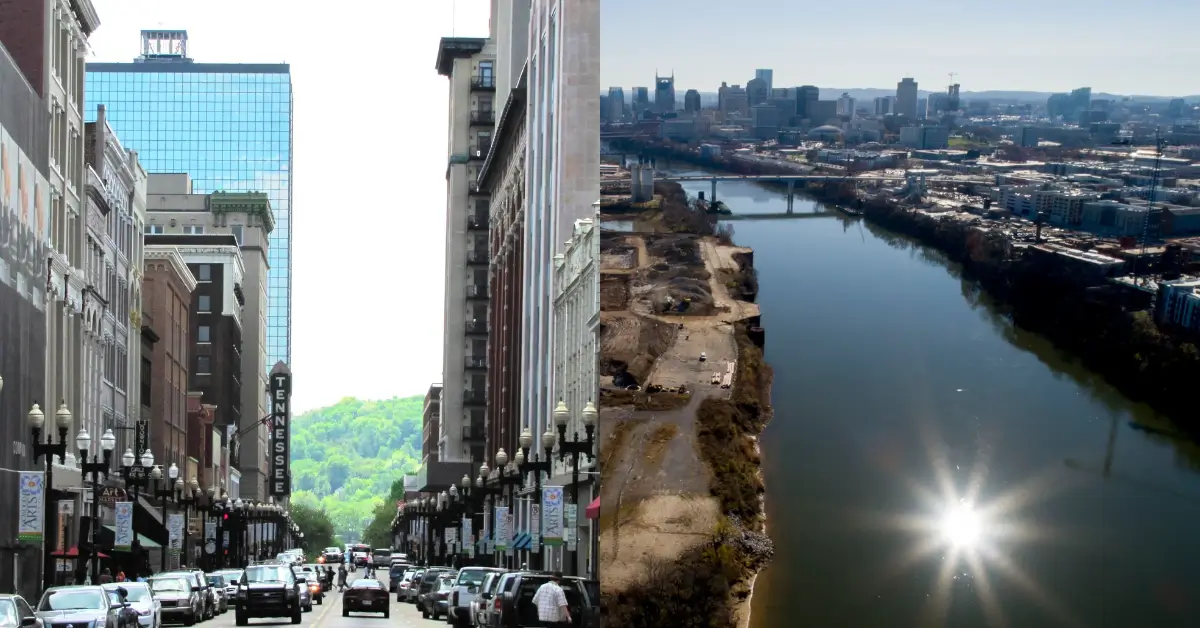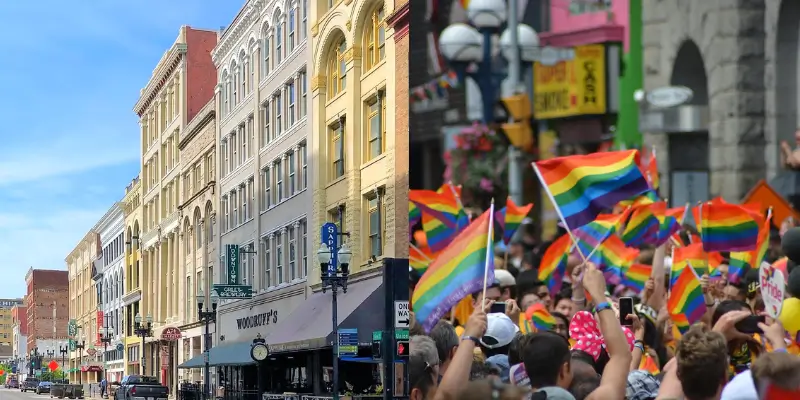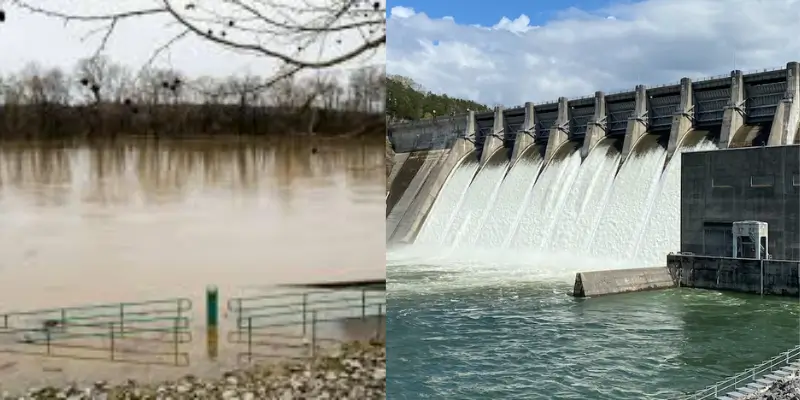Gay Street and Cumberland River: A Journey Through History, Culture, and Natural Beauty

The rich heritage of Gay Street, Knoxville, and the mighty Cumberland River offers an incredible blend of history, modern-day attractions, and natural beauty.
These two iconic landmarks not only shape the cities of Knoxville and Nashville, Tennessee but also form a vital part of Tennessee’s broader cultural and geographic fabric. Let’s dive into the fascinating history of Gay Street and Cumberland River and explore the vibrancy and significance of these locations.
Introduction
Knoxville’s Gay Street and the Cumberland River flowing through Tennessee represent some of the region’s most prized landmarks.
Gay Street stands as a living testimony to the cultural and economic transformation of Downtown Knoxville, while the Cumberland River serves as the lifeblood of various cities, including Nashville. Together, they represent the pulse of Tennessee’s history and future.
Whether you’re an avid historian, nature enthusiast, or simply someone looking to immerse yourself in the heart of Tennessee’s charm, Gay Street and the Cumberland River offer countless opportunities to explore, connect, and experience the very essence of the state.

Overview of Gay Street, Knoxville
Gay Street in Knoxville is a historic thoroughfare that has been the heart of Knoxville’s downtown since the late 18th century. Running through the heart of Knoxville, this street is known for its architectural beauty, rich culture, and vibrant urban life.
Lined with beautiful old buildings and contemporary attractions, Gay Street invites residents and visitors alike to take a walk back in time while enjoying modern-day conveniences.
The street is home to some of Knoxville’s most iconic landmarks, including the Tennessee Theatre, which has been dubbed the “Official State Theatre of Tennessee.” Gay Street is also the setting for many of Knoxville’s most celebrated festivals and events, adding a pulse of excitement to the city throughout the year.
Read Also: Andre Hakkak Net Worth
Historical Significance of Gay Street
The history of Gay Street is deeply intertwined with the history of Knoxville itself. First laid out in the 1790s, it quickly became a bustling center of commerce and politics.
The street served as a vital artery for Knoxville’s development during the Civil War era, with various businesses, banks, and government offices taking root. Gay Street also witnessed significant events in Tennessee’s history, from political rallies to social movements.
Its buildings have housed everything from movie theaters to law offices, all contributing to Knoxville’s rise as a key player in the region. The street’s past has been carefully preserved, making it an essential stop for history buffs and tourists alike.
Revitalization and Modern Attractions on Gay Street
Over the years, Gay Street has undergone extensive revitalization efforts to preserve its historic character while embracing modern urban development. These efforts have transformed Gay Street into a vibrant mix of culture, dining, and entertainment.
It’s now home to trendy coffee shops, upscale dining establishments, and boutique stores that capture the spirit of both old and new Knoxville. The rebirth of the Tennessee Theatre, as well as other historic buildings, has made Gay Street a prime destination for art lovers and performers alike.
As you stroll down the street, you’ll notice how the preservation of its architecture perfectly complements the influx of modern amenities. It’s a balance that makes Gay Street truly unique in Knoxville.
Major Festivals and Events on Gay Street
Throughout the year, Gay Street plays host to some of Knoxville’s most exciting festivals and events, including the Dogwood Arts Festival, which showcases the best of Knoxville’s local art scene. This festival lights up the street every spring with its mix of art, music, and cultural displays.
The Dogwood Arts Festival is not only a celebration of local creativity but also a testament to the revitalization of Gay Street as a cultural hub. During the holidays, Gay Street is transformed into a winter wonderland, hosting the Knoxville Christmas Parade.
Events like these draw thousands of visitors and add to the sense of community that makes Knoxville feel like home. Whether it’s the food, music, or artistic expression, the festivals on Gay Street capture the vibrant spirit of Knoxville.

Overview of the Cumberland River
The Cumberland River flows majestically through Tennessee and Kentucky, playing a vital role in the history and economy of the region. This 688-mile-long river begins in the Appalachian Mountains of Kentucky and winds its way through Tennessee, eventually joining the Ohio River in Kentucky.
The Cumberland River has been instrumental in shaping Tennessee’s landscape, providing vital resources for navigation, commerce, and industry. Its banks have nurtured cities like Nashville, where the river’s influence can be seen in the development of the Nashville riverfront and other waterfront parks.
Geography and Course of the Cumberland River
The Cumberland River cuts through a diverse range of landscapes, from the rugged Appalachian Mountains to the rolling hills of central Tennessee. Along its course, it serves as a Tennessee River tributary, creating vital waterways that support both wildlife and human settlements.
As the river meanders through cities like Nashville and Clarksville, it provides essential resources for commerce, recreation, and wildlife habitats. The Cumberland River is also known for its many tributaries, including the Wolf River, which adds to its vast network of waterways across Tennessee and Kentucky.
Economic Importance of the Cumberland River
The Cumberland River has historically been a crucial artery for trade and transportation. Before the advent of railroads, the river was a key route for moving goods across the region, connecting cities to the wider world.
Even today, the river supports a thriving commercial barge industry, transporting millions of tons of goods each year. Besides commerce, the river plays a critical role in energy production, with several hydroelectric plants generating power for the Tennessee Valley.
The Tennessee Valley Authority (TVA) manages these operations, ensuring that the river’s waters are used efficiently for both industrial and environmental needs. The river’s significance in navigation and trade cannot be overstated, making it an integral part of Tennessee’s economy.
Recreational Activities on the Cumberland River
Beyond its economic importance, the Cumberland River serves as a recreational playground for both locals and visitors.
Whether you’re looking for an exciting day of Cumberland River boating, a peaceful afternoon of fishing, or simply a scenic hike along the riverbanks, the Cumberland has something for everyone. Popular activities along the river include Cumberland River fishing, where anglers can catch catfish, bass, and more.
In urban areas like Nashville, the riverfront has been beautifully developed into parks, walking paths, and entertainment venues. These waterfront parks provide a perfect place for picnics, jogging, or even a sunset boat ride, showcasing the natural beauty of the Cumberland River against the backdrop of Tennessee’s cities.
Flood Control and Dams along the Cumberland River
Over the years, the Cumberland River has had a history of severe flooding, most notably in Nashville. To mitigate these risks, a series of Cumberland River dams and reservoirs have been constructed.
The Wolf Creek Dam, managed by the Tennessee Valley Authority (TVA), is one of the largest, playing a key role in flood control and ensuring that the river’s waters are carefully regulated.
These dams not only provide flood protection but also generate hydroelectric power and create recreational opportunities like lakes for boating and fishing. The careful management of the Cumberland River has allowed cities like Nashville to flourish, balancing the needs of industry, recreation, and environmental protection.

Connection Between Gay Street and Cumberland River
Though Gay Street and the Cumberland River serve different cities, they are linked by their roles in Tennessee’s development. Both are significant landmarks in their respective cities—Gay Street in Knoxville and the Cumberland River in Nashville—playing critical roles in their cities’ histories, economies, and cultures.
While Gay Street is a hub of urban culture, commerce, and history in Downtown Knoxville, the Cumberland River serves as the life-giving waterway that helped cities like Nashville grow and prosper. Together, they symbolize the enduring spirit of Tennessee, blending history, culture, and natural beauty into a unique experience for locals and visitors alike.
Read Also: Leomorg AI
Quick Facts
- Gay Street: A historic street in Knoxville, Tennessee, known for its cultural and commercial significance.
- Cumberland River: A 688-mile river that flows through Tennessee and Kentucky, joining the Ohio River.
- Tennessee Theatre: A historic theatre located on Gay Street, Knoxville.
- Dogwood Arts Festival: A major cultural event that takes place annually on Gay Street.
- Wolf Creek Dam: A critical dam along the Cumberland River, managed by the TVA, playing a key role in flood control.
- Nashville Riverfront: A major attraction along the Cumberland River, known for parks and entertainment.
Final Thoughts
Gay Street and the Cumberland River represent two of Tennessee’s most cherished landmarks. From the vibrant urban life of Gay Street, Knoxville, to the serene waters of the Cumberland River, these places capture the essence of Tennessee’s rich heritage and modern-day appeal. Whether you’re walking through Knoxville’s historic streets or sailing along the Cumberland River, the opportunities to explore and connect with Tennessee’s past and present are boundless.
FAQs
What is Gay Street known for?
Gay Street is known for its historical significance in Knoxville, Tennessee, and is home to cultural landmarks like the Tennessee Theatre.
Where does the Cumberland River start and end?
The Cumberland River begins in the Appalachian Mountains of Kentucky and flows for 688 miles, eventually joining the Ohio River in Kentucky.
What are some major festivals on Gay Street?
One of the major festivals on Gay Street is the Dogwood Arts Festival, which celebrates local art and culture.
How does the TVA manage the Cumberland River?
The Tennessee Valley Authority (TVA) manages the Cumberland River through a series of dams and reservoirs, balancing flood control, energy production, and recreation.
Can you fish on the Cumberland River?
Yes, fishing is a popular activity on the Cumberland River, with species like catfish and bass commonly caught.





